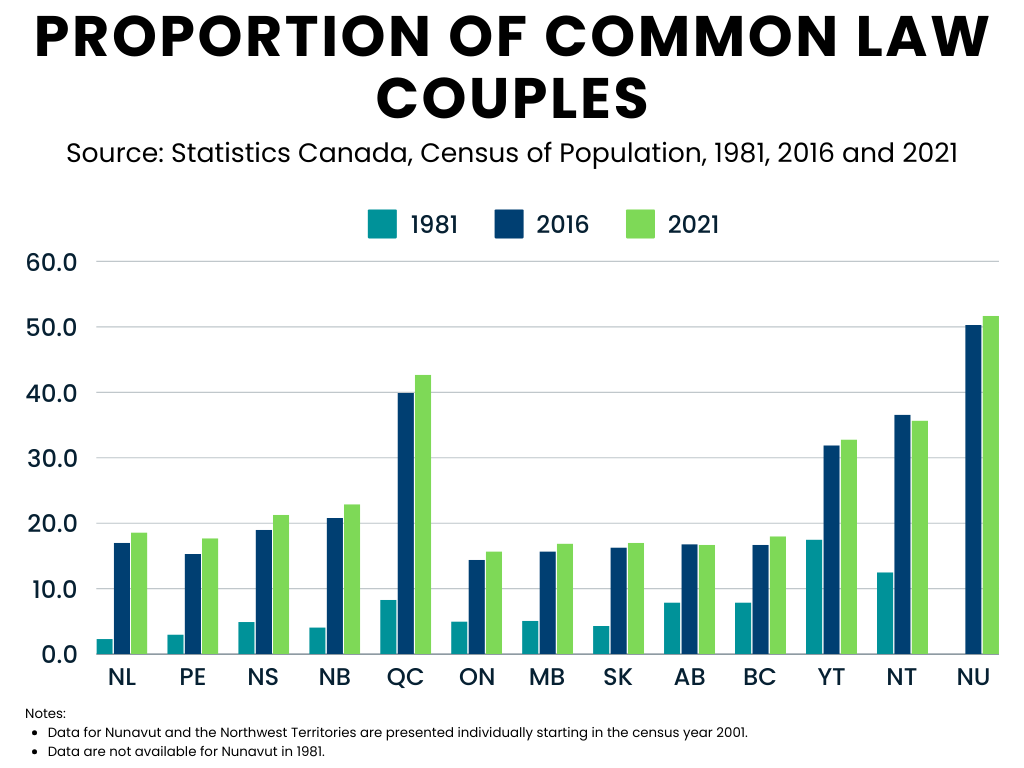
Discover the difference between common law partnerships and marriage, especially when it comes to property division. Find out what recourse common-law spouses have in case of separation

The idea of a traditional family is long gone. A modern family may now have stereotypical roles reversed (the women working; the men stay and take care of the home), and even those who are in a husband-and-wife relationship without getting married. As legal marriage is becoming less common, and divorce rates are on the rise, more and more couples are asking, what is the difference between common law and marriage?
This article can be used as a refresher for lawyers on the laws surrounding common-law unions. It can also serve as a client education piece to help couples understand the similarities and differences of marriages and common law relationships.
Becoming legally married and being in a common law relationship are two legal relationships that are treated differently under Canadian laws. Both are similar in the sense that they involve two persons, regardless of gender and sex. They may or may not be living together, with or without children.
However, the effects of such relationship are important areas of distinction. Let’s first define what these relationships are under the law.
Marriage is the lawful union of two persons, in addition to the various requirements set by federal and provincial laws:
Usually, we refer to common-law relationships as two people in a romantic relationship; it means more than that. Legally, it’s when two people live together (or cohabit) conjugally for a given period, but without marrying each other.
These relations are also called common-law unions under the law and fall under provincial statutes. They set out specific standards before someone may be considered as a ‘common-law spouse’ for legal purposes. In addition, some federal laws may also have similar or different standards for other purposes (e.g., for immigration).
This video explains what common-law spouses are under British Columbia laws:
If you’re looking for lawyers to help with your common law or marriage issues, check out our Special Reports on the top law firms in Canada in our Rankings page.
Provincial laws outline the minimum periods that couples should live together to be considered common-law spouses. Each province has different rules, which is why it’s important that couples always consult or hire an estate lawyer.
As an example, here are two provinces with different periods and standards:
|
British Columbia |
Ontario |
|
|
A couple must have lived together for these minimum periods in a marriage-like or conjugal relationship, for each to qualify as a spouse under the law. This period usually starts on the day that the couple starts living together. After this, the common-law couple will have the same rights and responsibilities as that of a married couple, but that still depends on their provincial law.
Although there are other differences between common law and marriage, there are two main issues in this area of family law:
The Supreme Court of Canada has upheld the differences between common law unions and legal marriages when deciding on property division and spousal support. In a case commonly referred to as Eric v. Lola (Quebec (Attorney General) v. A, 2013 SCC 5), the Supreme Court decided that the laws as they applied to common law couples did, in fact, violate the Charter, but that the violation could be justified under s. 1.
In an earlier decision known as Walsh v. Bona (Nova Scotia (Attorney General) v. Walsh, 2002 SCC 83), the Court ruled that it was not discriminatory for the Nova Scotia Matrimonial Property Act to exclude common law couples from the definition of “spouse.”
“They say, people choose not to get married for a reason,” said Stephen Grant of Grant Crawford Watson LLP in Toronto. Grant has handled dissolution of common law and legal marriages in his practice. “The courts have been clear that there is a definite distinction between marriage and cohabitation,” he said.
Robert Shawyer of Shawyer Family Law & Mediation in Toronto said that the decision in Walsh v. Bono was made prior to more recent Charter cases. He added that the decision in Eric v. Lola dealt with the Civil Code of Québec, not with the other provinces’ property regimes.

Shawyer said that property regimes in provinces such as Ontario and Alberta would be held to be unconstitutional if challenged. “From my reading, [Quebec v. A] applied strictly to Quebec’s civil law system and division of property, which is rules- and statute-based.” This is opposed to common law jurisdictions which are rules- and precedent-based.
In her dissent in Quebec v. A, Justice Rosalie Abella alluded to Walsh v. Bono, which challenged Nova Scotia’s property law division. “She said the problem with that [decision] was that it . . . doesn’t accord with the more updated jurisprudence in regard to how you determine whether something is discriminatory.” Shawyer said that this confused the government’s obligation to defend the law under s. 1 with the moving party’s obligation to prove discrimination.
“It really does come down to, all things being equal, a moral question, whether or not we are willing to accord the same rights to common law couples as to legally married couples.”
Amendments to the Divorce Act did not include property rights for common law couples. As a result, there is a hodgepodge of property regimes. “If you look internationally, you’ll see that other common law jurisdictions have the same sets of property rights for common law as for married couples.”
Encouragement by the federal government to make property division and spousal support in common law relationships consistent with the regime for married couples “would be helpful. But at the end of the day, what it's going to require is constitutional challenges.”
As part of financial implications, there are different effects between dissolution of marriages through divorce or annulment versus the separation of common law spouses. When people legally marry, they can trust that assets accumulated during their marriage will be divided equally if the marriage dissolves.
That’s not the case for common law couples in most of Canada. However, even where it is not legislated, courts may be increasingly recognizing that property rights apply to cohabitants.
For example, when one of the spouses in a marriage dies, the laws on intestate or testate succession will apply to their property relations. When they separate, the federal Divorce Act or Civil Marriage Act will apply.
For common-law spouses, some of these laws might not apply. Separation of common-law couples would only matter under the law:
There are more protections and options available to legally married spouses under the law. However, there are court precedents and decisions that common-law spouses can also rely on to protect their rights.
Property division on dissolution of common law marriage has “been an issue for decades,” said Robert Leckey, dean of the Faculty of Law at McGill University. Some provinces changed their laws to treat common law couples the same as legally married couples on dissolution of the relationship. These provinces include:
“Where that hasn’t been done, courts are adapting the common law rules they work with,” said Leckey. “Sometimes, we have the idea that if the legislature doesn’t act, the law stays static. That's not happening.”
In jurisdictions where the law has not been reformed by legislators, “the courts have been gradually changing, with a view to try to mitigate some of the injustice perceived as arising when a couple breaks up after a long cohabitation,” he says.
To fill this void in our laws, some legal practices have been allowed through court decisions and provincial laws for common-law spouses. We’ll discuss some of these below:
In jurisdictions where some of the rights of a legal marriage are not available to common law relationships, common law spouses may enter into a written contract or agreement. Usually, these are created before or during the relationship, which will take effect during the existence of the relationship, and/or when the couple separates.
It may cover these aspects:
The above examples are not exhaustive, and couples may agree on other rights and obligations that they want to set in black and white. What’s important is that it does not violate any law or that it does not contain any illegal provision.
Immigrants to Canada are less likely to have their unions end in separation than the Canadian born: new Statscan report.
— Canadian Affairs (@CDNAffairs) March 19, 2024
24 per cent of first marriages ended in separation or divorce, compared to 65 per cent of first common law relationships.
Read more:https://t.co/kudOpwSM1c
Property relations between common-law couples after one of them dies is best outlined in a last will and testament. Succession laws must be followed when it comes to the transfer of properties between persons outside of marriage (such as common-law spouses).
In short, while conjugal or common law agreements are effective during the relationship and after common-law spouses separate, wills shall take effect after the death of one spouse.
A cohabitant can seek money from another under the principle of unjust enrichment with the help of the court. This principle says that if one party has enriched another and later been deprived as a result, that party can ask the other to return some of that enrichment.
Leckey has a five-year research grant to look at cohabitation and legal reforms in provinces such as B.C., Saskatchewan, and Ontario.
His research is on common-law bases for making a claim against a former partner for unjust enrichment. In Saskatchewan and B.C., Leckey saw “a slight change in profile, a broader range of families accessing the courts and amounts of money given up, but not a revolution.” Notably, these two provinces have new legislation that say property must be divided equally on breakup.
When situations turn sour, and there’s a need for court intervention, one of the parties may ask for a declaration of a constructive or a resulting trust in their favour. In both cases, one person contributes to the acquisition of a property, but the legal title is vested upon another person.
As such, the court may declare that an interest be created for the contributing person, in whole or in part of the property. One application of these trusts is when one of the common-law spouses helped pay for a property, such as their common home, but its title is named after the other.
However, there are distinctions between a constructive trust and a resulting trust:
The goal of a declaration of trust relationship is to bring equity among the parties, by honouring what they really intended, and by protecting the interests of both parties.
At some point, couples will be thinking whether to live together or to wait before getting married. While this may be the last thing on their minds, given all the busy-ness of running a family, it’s also important that they know about the difference between common law unions and marriage. This will help couples in the long run and for legal purposes, ensuring that there’s peace within the family.
Visit our page on Family Law for more resources on the difference between common law unions and marriage, including other important court decisions and new laws.